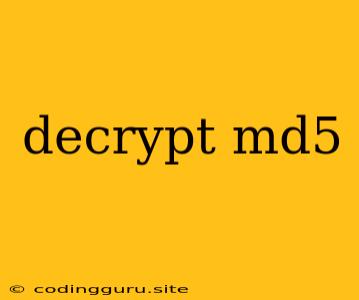Decrypting MD5 Hashes: An Overview and Considerations
MD5, standing for Message-Digest Algorithm 5, is a widely used cryptographic hash function. It takes an input of any length and produces a fixed-length output, known as a hash or checksum. This hash is a unique fingerprint of the original data, often used for verifying data integrity and authenticity. However, MD5 is considered cryptographically broken, meaning it's susceptible to collisions and brute force attacks, making it unsuitable for security purposes like password hashing.
What is Decrypting MD5?
Decrypting MD5 is the process of trying to recover the original input data from its corresponding MD5 hash. This is a challenging, often impossible task, as MD5 is a one-way function, designed to be irreversible. It's crucial to understand that there's no straightforward "decryption" process for MD5 hashes.
Why is Decrypting MD5 Difficult?
The difficulty in decrypting MD5 stems from its design principles:
- One-Way Function: MD5 is designed to be a one-way function, meaning it's easy to calculate the hash from the input but extremely difficult to reverse the process and obtain the input from the hash.
- Collision Susceptibility: Due to its vulnerability to collisions (where different inputs generate the same hash), it's possible to find multiple inputs that produce the same MD5 hash. This makes it unreliable for authentication and integrity checks.
- Hash Size: MD5 generates a 128-bit hash. This means that there are a massive number of possible hashes (2^128), making it computationally infeasible to brute force all possible inputs to find a match.
Can MD5 be Decrypted?
While it's technically impossible to "decrypt" an MD5 hash in the traditional sense, there are some scenarios where you might be able to retrieve the original input:
- Pre-Computed Hash Databases: Some online services maintain databases of pre-computed MD5 hashes for common words, phrases, and passwords. If your MD5 hash happens to be in this database, you can potentially find the corresponding input.
- Brute Force Attacks: For simple inputs like short passwords, brute force attacks might be feasible. However, this becomes extremely time-consuming and resource-intensive as the input size grows.
- Rainbow Tables: Rainbow tables are pre-computed tables that store MD5 hashes and their corresponding inputs. They can be used to quickly look up an input based on a known hash, but they require significant storage space and are often outdated.
Best Practices for Security
Given the weaknesses of MD5, it's highly recommended to avoid using it for security-sensitive applications:
- Use Stronger Hash Functions: For secure password hashing, choose stronger algorithms like SHA-256, SHA-512, or bcrypt. These offer increased resistance to collisions and brute force attacks.
- Salt Passwords: Salting passwords adds a random string to the password before hashing, making it more difficult for attackers to use pre-computed hash databases.
- Implement Secure Authentication Practices: Use multi-factor authentication (MFA) and avoid storing passwords in plain text.
Conclusion
Decrypting MD5 hashes is a challenging task, often impossible due to its one-way nature and susceptibility to collisions. While there are methods like pre-computed databases or brute force attacks, they have limitations and may not always be successful.
For secure applications, it's crucial to move away from MD5 and utilize stronger, more secure hash functions, along with best security practices. It's important to stay informed about the latest vulnerabilities and security best practices to ensure the integrity and security of your data.
